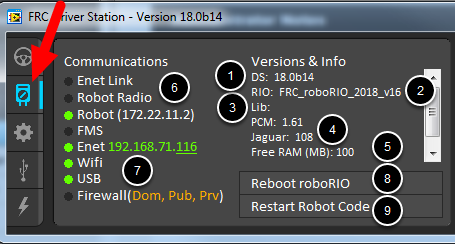

the switch is open), the limit switch feature is default to “normally open”. Since an “out of the box” Talon will likely not be connected to limit switches (at least not initially) and because limit switch inputs are internally pulled high (i.e. When a limit switch input is closed (is connected to ground) the Talon SRX will disable motor drive and individually blink both LEDs red in the direction of the fault (red blink pattern will move towards the M+/white wire for positive limit fault, and towards M-/green wire for negative limit fault). This means that motor drive is allowed when a limit switch input is not closed (i.e. Talon SRX in particular can automatically do this when limit switches are connected via the Gadgeteer feedback port.Īn “out of the box” Talon will default with the limit switch setting of “Normally Open” for both forward and reverse.

Talon SRX and Victor SPX have limit features that will auto-neutral the motor output if a limit switch activates. Sensor Position and Velocity, the signed output of the selected Feedback device (robot must select a Feedback device, or rely on default setting of Quadrature Encoder). Quadrature Encoder Position, Velocity, Index Rise Count, Pin States (A, B, Index)Īnalog-In Position, Analog-In Velocity, 10bit ADC Value,Īpplied Throttle (duty cycle) regardless of control mode.Īpplied Control mode: Voltage % (duty-cycle), Position/Velocity closed-loop, or follower.Ĭlosed-Loop Error, the difference between closed-loop set point and actual position/velocity. These signals are available in API regardless of what control mode the Talon SRX is in.Īdditionally the signals can be polled using Phoenix Tuner using the Self-test Snapshot button. This improves bus efficiency by removing the need for “request” frames, and guarantees that the signals necessary for the wide range of use cases they support are available. The Talon FX/SRX and Victor SPX transmit most of their status signals periodically, i.e. The below table details what neutral deadband strategy the Talon FX uses under the various states. The below graph highlights this, exaggerrating the effect to make it obvious. This is used only in follower mode so you don’t have to configure the deadband of your followers, only of the master. A deadband of 4% with 4% requested output will apply 4%, 5% is 5%, and 100% is 100%. With a 4% deadband, a requested output of 4% will result in an applied output of 0%, requesting 5% will bring it to 1%, and 100% will be 100%.Ī None deadband will not uphold the deadband whatsoever. This allows for a smooth transition out of neutral. This is used in the majority of circumstances so it’s obvious that the requested output is the applied output outside the neutral deadband.Ī Continuous deadband is similar to a simple deadband in that it demotes any requested output within the region to neutral, but outside the region it will scale the applied output so it’s continuous out of the deadband thresholds. An example of this is with a configured deadband of 4% and a requested output of 4% will be 0%, 5% output will be 5%, and 100% will be 100%. They are Simple, Continuous, and None.Ī Simple deadband will demote any requested output within the region to neutral, and otherwise uphold the requested demand. Talon FX has 3 different deadband strategies based on its state.

configNeutralDeadband ( 0.001 ) /* Configures _talon to use a neutral deadband of 0.1% */ All of the above signals are automatically restored even after motor controller is power cycled during use except for Status Frame Periods, which can be manually restore by polling for device resets via hasResetOccurred(). These control signals do not require periodic calls to ensure they “stick”. Soft Limit override (convenient to temporarily override configs) Limit switch override (convenient to temporarily override configs) Neutral mode override (convenient to temporarily override configs) Voltage Compensation Enable (though the nominal voltage is a config)Ĭontrol Mode and Target/Output demand (percent, position, velocity, etc.)Ĭlosed-loop slot selection for primary and aux PID loops. The majority of the behavior in the Talon/Victor is controlled via configs, however there is a small number of control signals that are controlled via the API.Ĭurrent Limit Enable (though the thresholds are configs)


 0 kommentar(er)
0 kommentar(er)
